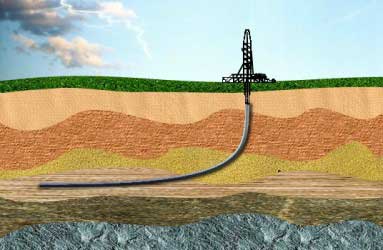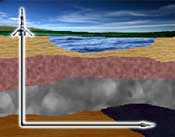TECHNOLOGY section
2. Horizontal Drilling
Horizontal oil and gas well drilling has become one of the most valuable technologies ever introduced in the business. It is an enhanced oil recovery (EOR) or gas recovery method that is becoming more and more popular as the price per barrel of oil gets higher.
Unlike a directional well that is drilled to position a reservoir entry point, a horizontal well is commonly defined as any well in which the lower part of the well bore parallels the oil zone. The angle of inclination used to drill the well does not have to reach 90° for the well to be considered a horizontal well. Applications for horizontal wells include the exploitation of thin oil-rim reservoirs, avoidance of drawdown-related problems such as water/gas coning, and extension of wells by means of multiple drain holes.
Wells are drilled directionally for several purposes:
- Increasing the exposed section length through the reservoir by drilling through the reservoir at an angle
- Drilling into the reservoir where vertical access is difficult or not possible. For instance an oilfield under a town, under a lake, or underneath a difficult to drill formation.
- Allowing more wellheads to be grouped together on one surface location can allow fewer rig moves, less surface area disturbance, and make it easier and cheaper to complete and produce the wells. For instance, on an oil platform or jacket offshore, 40 or more wells can be grouped together. The wells will fan out from the platform into the reservoir(s) below. This concept is being applied to land wells, allowing multiple subsurface locations to be reached from one pad, reducing costs.
- Drilling along the underside of a reservoir-constraining fault allows multiple productive sands to be completed at the highest stratigraphic points.
- Drilling a "relief well" to relieve the pressure of a well producing without restraint (a "blow out"). In this scenario, another well could be drilled starting at a safe distance away from the blow out, but intersecting the troubled wellbore. Then, heavy fluid (kill fluid) is pumped into the relief wellbore to suppress the high pressure in the original wellbore causing the blowout.
Most directional drillers are given a well path to follow that is predetermined by engineers and geologists before the drilling commences. When the directional driller starts the drilling process, periodic surveys are taken with a downhole instrument to provide survey data (inclination and azimuth) of the well bore. These pictures are typically taken at intervals between 30–500 feet, with 90 feet common during active changes of angle or direction, and distances of 200–300 feet being typical while "drilling ahead" (not making active changes to angle and direction). During critical angle and direction changes, especially while using a downhole motor, an MWD (Measurement while drilling) tool will be added to the drill string to provide continuously updated measurements that may be used for (near) real-time adjustments.
©2012 Harrison Lease Acquisition & Development Corp.—All rights reserved

